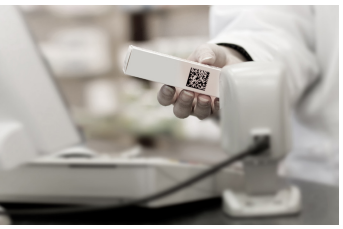Why does the pharma industry use GS1 DataMatrix 2D barcodes on their packaging

The healthcare industry is facing market forces such as drug counterfeiting placing global public health at risk , social reimbursement fraud, ineffective product recalls, and supply chain inefficiencies.
As a result of country based initiatives such as the US Drug Supply Chain Security Act (DSCSA) and the European Union Falsified Medicines Directive (FMD) combined with healthcare regulators , manufacturers and supply chain partners are looking towards having a global standardised identification system from manufacturer to patient to support product traceability and combat drug counterfeiting.
These legislative mandates have introduced the concept of mass serialisation where the end selling packaging unit is uniquely serialised based on a random number.
Pharma supply chains are complex and global in nature, and when trading internationally to support product traceability (track and trace) the pharma industry is attempting to implement standards using a common identification system like GS1.
Country vs International
US manufacturers using a combination of the National Drug Code (NDC) and a serial number will meet DSCSA guidelines, which is perfect when trading domestically, but if the product is exported to the EU for example, the NDC is not a recognised protocol. The FDA does not enforce the use of the NDC number, and have left manufacturers to make their own decision and thus they have adopted the international product identification standard: GS1 and the Global Trade Item Number (GTIN).
Why GS1 ?
The GS1 system is a globally recognised and endorsed standard by the healthcare supply chain, (as well other regulated industries such as food and beverage) and is widely used. Based on a foundation of unique identification keys , the Global Trade Item Number, and product attributes such a batch/ lot number, expiry date, unique serial number etc, it is uniquely suited to meet the needs of the healthcare industry.
What is a GS1 DataMatrix 2D barcode
GS1 DataMatrix is the preferred two-dimensional (2D) matrix bar code symbology that efficiently meets all of the needs of the pharmaceutical (and medical device industry) by:
- The encoding and marking of large amounts of data within a small space
- Enabling direct part marking
- Providing error detection and correction capabilities
- Allowing the printing of variable information at high production rates
The format of the GS1 DataMatrix is a series of data encoded black and white modules, arranged in a compact square pattern, which can store up to 2,335 alphanumeric characters , based upon a pre-determined module and grid size plus a mathematical formula. Readable in an omni-directionally manner (360-degree orientation) contains the following data:
- Global Trade Item Number (GTIN) – 14 digits
- Expiry Date – 6 digits (YYMMDD)
- Batch / lot Number – up to 20 alpha-numeric characters
- Unique Serial Number (randomized) – up to 20 alpha-numeric character
What about QR Codes ?
GS1 2D barcodes come in two formats GS1 Datamatrix vs QR Codes. They are both similar containing the necessary data required of the industry, but the QR Code can hold more data such as a url to a website to view product information or a video used for marketing purposes. With the advent of smartphones and enriching the customer experience more and more pharma enterprises are adding QR Codes for marketing purposes on packaging materials.
Where are they used?
Depending on the legislation of the country, the frequency of serial number verification will differ , for example within the EU , to close the loop between the manufacturer, European Medicines Verification System and the patient, the GS1 DataMatrix is scanned at the pharmacy to verify if the serial number of the product being sold and dispensed to the patient is an authenticate serial number.
Produmex Life Sciences for Distributors and Manufacturers
With Produmex Life Sciences an industry solution for SAP Business One, pharmaceutical enterprises are able to achieve compliance, providing the following benefits business.
- Perform inventory related transactions with combined batch/lot and serial number of the end selling unit
- Optimize inventory transactions and advanced shipping notifications (ASN’s) using GS1 2D barcodes and SSCC license plates to support aggregation
- Connect to multiple channels such as country specific National Medicines Verification System (NMVS), including standalone serialisation and track and trace systems
- Provide product and serial number authentication via mobile applications to support verification, product decommissioning and reactivation via the cloud
- Accurately trace and quickly recall products in the supply chain to minimize operational costs
For more information download the brochure
